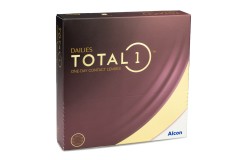Spheric vs. Aspheric: Which lenses are better?

There are many considerations when choosing the right contact lenses. Do you pick daily, weekly or monthly lenses? There are also coloured lenses, multifocal lenses or lenses specially made for presbyopia.
Not to mention the different combinations of prescriptions that are possible today. Today, almost every refractive error can be corrected with the help of contact lenses.
But there is another element to bear in mind. The shape. This determines whether your contact lenses fit well and correct your vision properly. The curvature of the lens plays a big role when it comes to getting the best visual results. Read our guide to find out how the lens shape is crucial for your vision and the comfort of your eyes.
Spheric and aspheric contact lenses
The curvature of a contact lens can be either spherical or aspherical.
Aspheric contact lenses provide more precise light guidance than spheric contact lenses.

Spheric lenses have excellent imaging properties. But when it comes to severe ametropia, aspheric surfaces perform better. This is particularly evident in the marginal areas of the lenses. From there, the light is directed to the focal point of the visual aid.
For the wearer, this results in a clearer, brighter image, and a less restricted visual range, as more of the lens can be used for viewing.
Looking for the right contact lenses?
A wide selection of cutting-edge lenses awaits you at Lentiamo!
Top manufacturers offer you a wide range of daily and monthly lenses made of silicone hydrogel, extended-wear lenses and UV and blue light filters.
What are the limits of spheric lenses?
Spherical contact lens models are more commonly worn than their aspherical counterpart. For a long time, there were no other forms of contact lenses at all. But they are not always the best choice due to their sometimes inadequate optical quality. They can cause aberrations that lead to blurred vision.
Opticians call this phenomenon spherical aberration because it only occurs in spherically shaped optical lenses. It occurs because not all light rays that hit the lens surface subsequently converge at the same point. The rays' incidence in the area of the curved lens edge are refracted differently than those in the axis area. Thus it is not possible for the eye to focus all rays at the same time. This results in a blurred image.
Aspherical contact lenses for improved visual comfort?
In comparison to spheric lenses, aspheric ones have a curvature in order to sit optimally on the eyeball. But their edges are flattened. The flat curvature changes the optical properties of the lens. The latest manufacturing processes make it possible to produce this special shape.
The largely freely formable surface allows the avoidance or reduction of aberrations that are unavoidable with spherical lenses.
The lenses can be better adapted to the curvature required by the eye. They deflect light rays as required by the wearer and avoid image errors. Therefore, an optimal visual result is achieved.
Are aspheric contact lenses suitable for every contact lens wearer?
If you suffer from an eye disease, it is best to consult an ophthalmologist. He or she will determine whether your eyes are suitable for wearing contact lenses at all. Generally, ophthalmologists do not recommend wearing aspheric lenses if your hyperopia has been corrected by laser eye surgery.
The situation is different for patients with cataracts. Since the effects of spheric aberration are stronger, ophthalmologists recommend aspheric contact lenses, or spectacle lenses in this case. In addition, the type of ametropia, as well as eye diseases, play a major role. Lenses with an aspheric front are the best choice in cases of severe nearsightedness or farsightedness. People with a large pupil diameter should also use this type of lens.
Aspherical contact lenses at a glance
- Aspheric contact lenses are similar to their spheric counterparts. However, they do not have a spherically curved surface and their edges are flattened, so the image is less distorted than with spheric lenses. The vision is sharper due to better peripheral imaging.
- Aspheric contact lenses prevent so-called spherical aberrations, i.e. the peripheral distortions caused by pupil enlargement during some activities.
- The aspheric lens design can help to increase visual acuity even in poor lighting conditions, or when driving in the dark, when working with a computer, or for sports activities that require fast focus.
- Aspheric lenses can correct low astigmatism up to –0.75, or presbyopia.
- BUT: There are individuals who do not benefit from the aspheric lens surface. Their eyes depend on spherical aberrations to ensure optimal vision.
Check out Lenjoy, the most affordable, aspheric lens in our online shop. The unique aspheric design of the Lenjoy lens lowers aberrations and helps vision acuity even in bad light conditions.








Comments